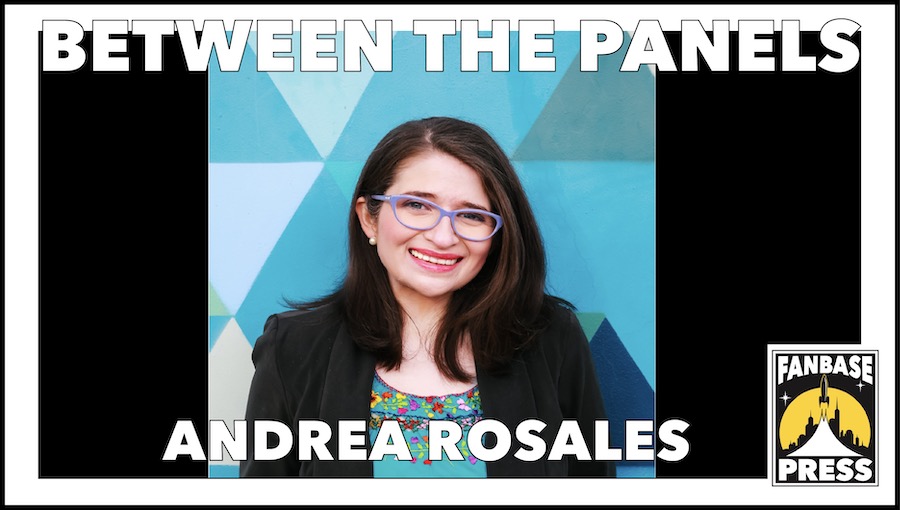“Between the Panels” is a bi-weekly interview series focusing on comic book creators of all experience levels, seeking to examine not just what each individual creates, but how they go about creating it.
To say that Andrea Rosales followed a circuitous path into comics is underselling the saga. From graphic design to animation to digital media, Andrea gained experience in multiple disciplines before ultimately bringing her gifts to this storytelling medium we all know and love.
First off, the basics…
Your specialties (artist/writer/letterer/inker/etc.): artist, inker, graphic design, puns
Your home base: Portland, Oregon
Website: andrearosales.com
Social Media
Facebook: AndreaRosalesArt
Instagram: @andrealrosales
Twitter: @andrealrosales
Bluesky: @andrearosales.bsky.social
Ko-fi: ko-fi.com/arosales
Fanbase Press Contributor Kevin Sharp: To start off with the big question: Why comics? As someone who’s worked in various illustration fields, what does comics offer you that keeps you coming back?
Andrea Rosales: An excellent question! To which I honestly can’t help but respond with “why not comics?” Comics is truly a unique and captivating art form that offers virtually limitless possibilities and opportunities for engaging, thoughtful, and dynamic storytelling. It does this while being something that can be experienced both universally and on a personal, individual level. Everyone reads a comic and experiences it individually, but the way in which it can resonate and lead to both connection and conversation on a global level is impactful and especially important in today’s world.
While I’ve worked in various other mediums and creative fields, I keep coming back to comics because I honestly just love to draw and I love for people to experience drawn stories on the page and take in all the parts of a comic that make it what it is – pictures, words, design, and the hard work of many creative people. Not only that, but there’s an amazing variety of comics in terms of styles and genres. You can do anything in comics and people get to immerse themselves in it in a very personal and deliberate way, which is rad in a time where a million things are constantly vying for your attention.
KS: When you were growing up, what were the types of art that originally captured your interest?
AR: I always loved to draw. It was just something I always kept coming back to. It was fun, a distraction—and if I’m being honest, a comfort since, apart from academics, I never felt like I was really good at anything else. While I took music lessons growing up, unlike playing piano or clarinet, with drawing no one could hear my mistakes, no one could judge me if I totally got it wrong. I could crumple up a piece of paper and start fresh. The promise of a blank page is a hopeful thing, and it was nice to have a creative outlet that could just be only for myself if that’s what I wanted. I don’t recall going to comic shops as a kid —I don’t remember many in my area growing up— but I do remember snagging a few of my brother’s issues of Spider-Man, Superman, and Batman when he was done reading them and ogling over the art for hours. While I loved staring at those pages, I really got interested in comics by reading syndicated comic strips in the paper. Every day after school, it’d be a tug of war with my older sister and brother trying to see who would be next to read the funnies section. I was always last because, while I am a very fast reader, I am a slow reader when it comes to art if that makes any sense. I would study the art.
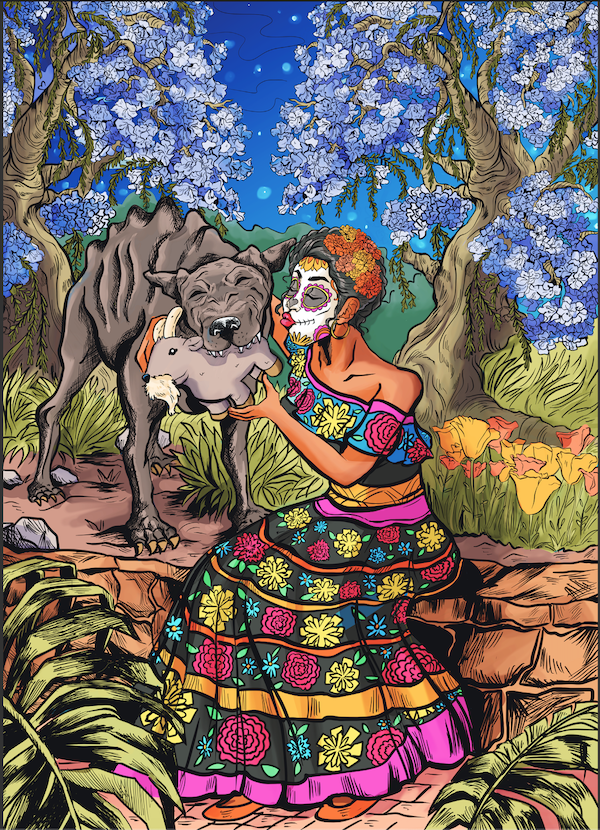
KS: Did the siblings all have the same taste, or did everyone like something different?
AR: The strips that captured my attention were the ones where you got to see the day in and day out of people’s lives. I loved Lynn Johnston’s For Better Or For Worse, Ray Billingsley’s Curtis, and Greg Evans’ Luann because I got to see kids going through their lives running into troubles with school, their friends, parents, etc. and working through it all. I loved being able to see them grow up and learn things about themselves along the way. I especially loved that the comics didn’t just show the kids growing and changing, it was their parents adjusting and changing their mindsets, too, which I felt was tremendously refreshing since the adults around me in my youth had a certain sort of rigidity about them —and still do.
As far as my siblings go, I think my brother also enjoyed Curtis. I’m not certain what my older sister enjoyed, but I think she relished reading everything. She always got the Arts & Culture/ Comics pages first, because she was the fastest reader. I got it last since while I was a fast reader, I would take my time and ogle the artwork.
KS: Aside from your brother’s issues, were you reading comics at all during this time?
AR: In middle school my best friend introduced me to manga and I was hooked. Akira Toriyama and Rumiko Takahashi were art inspirations for me, and in high school, I had a routine of reading my favorite web-comics and blogs after school right before I’d do my homework. While I didn’t read many comics during my college years, shortly after graduating, I became really inspired by mainstream and indie comics, as well as anthologies where I could see an incredible blend of styles telling diverse stories in different genres. I adored Darwyn Cooke’s New Frontier.
KS: That’s a perfect segue into our theme at Fanbase Press the past few years: “Stories Matter.” What was a comic book story that had an impact on you as a younger reader, something that came to you at exactly the right time?
AR: I love the theme of “Stories Matter” because they truly do. The right story at the right place and at the right time in your life can truly make such a tremendous impact and difference. I believe that the right comic at the right time can save lives even. An experience I can share that pertains to this theme is during a time in my early 20s when I had a pretty terrible set of months. I had lost my job, been in a car accident, had to move out of my apartment, and I had been sending job application after application getting no hits. At that moment I had felt so depressed, and so aimless. Making comics was something I was only just getting into and I still had my doubts as to whether or not I could make it. There were concerns I had that I couldn’t fit into what seemed to me a predominantly male industry, and then being a Latina, I didn’t know if there would ever be a space or a place for the themes and cultural perspectives I knew I’d be interested in sharing through comic form one day.
All these doubts felt overwhelming and what made a huge difference was being introduced to the Blue Beetle comic by John Rogers, Keith Giffen, and Cully Hamner by my editor on Nine Twilights at the time. In that book I was blown away by Jaime Reyes and his tight-knit family which instantly connected to me since they were Mexican-Americans in El Paso, Texas, which is where my family is from. It felt remarkable to read about a superhero that I could connect with culturally, and I felt I could also connect with his struggles to make sense of his powers and how he could be of service to his community because I was going through the same thing in a sense – trying to figure out how I could use my art skills and abilities to make a positive difference. Through that book I saw that if there could be stories about heroes who come from my same background, then surely there would still be more places and spaces for more stories like that.
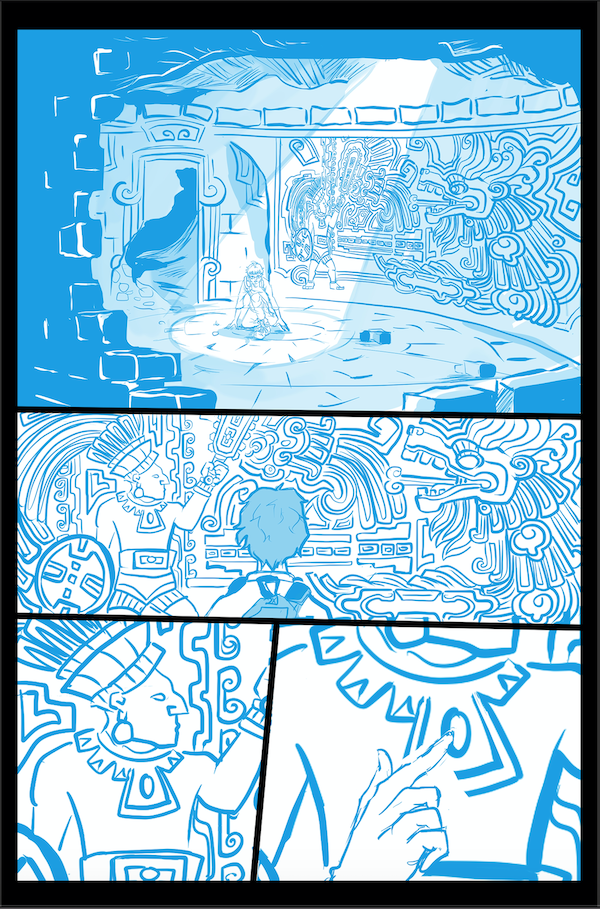
KS: Can you recall when you had the idea of pursuing art “for real?” That is, In terms of your thinking changing from this as a hobby to a potential career, was it a sudden moment of inspiration or something long simmering?
AR: [It] hit me at some time in middle school when I remember watching the end credits for The Incredibles, and it dawned on me that all of the creators on the film must be getting paid somehow. Similarly, looking at the credits in comic books I enjoyed, I understood that publishers had to be paying everyone who contributed to the publication, and so this gave me hope that perhaps someday my work could be in those pages. I had a pretty limited exposure to visual arts growing up. I understood that art was an actual career path for people, I just didn’t have much exposure to how one would even get started. My parents were doctors and most of my adult family members were in very different fields than the arts. Despite all of this, though, I knew that somehow, in some way I wanted to share my drawings with other people. What started out as drawing comic strips after school and doodling portraits of my classmates led to my mom signing me up for a few sessions of cartooning classes with Randy Emberlin and filling out as many sketchbooks as I could after school. I read tons of webcomics and doodled endlessly while taking notes in class, too.
KS: You got your degree in graphic design and animation. Did you have a career path in mind when choosing that line of study? Was there a particular discipline where you felt called, so to speak?
AR: When I started at Loyola Marymount University, I was excited about what graphic design could accomplish visually and the creative practicality of it. Knowing how to design things was something I instinctively knew that could be applied to a lot of creative disciplines. In my sophomore year at LMU, I added on an animation minor since I’d always loved animation and if I’m quite honest, I became much more interested in animation than graphic design, namely because it seemed a lot more drawing involved than most of my design coursework. I graduated wanting to develop a career in animation, specifically as a visual development artist, but there were so many skills I lacked to gain a proper foothold in that arena and I couldn’t afford any classes. I worked graphic design for a few years, taking figure drawing classes and reading as many books I could find about visual storytelling, specifically storyboarding.
KS: To jump to your post-college life… Your bio says you worked in Los Angeles for various companies for 6 years. Was this a fulfilling time professionally/creatively for you?
AR: During those years I did graphic design for a local non-profit, a manga publishing company, and a YouTuber fitness brand, and while it was good to have the experience of so many different organizations, I wished for the ability to be more creative in the work itself. Much of the work, while not all, was very cookie-cutter sort of design and while I enjoyed being able to learn more about pre-press and preparing media for print or digital needs, every day after work I longed to draw. Drawing was all I could think about all day and, of course, by the end of the day, I’d typically be too tired to do it, especially after those very long LA-traffic-filled commutes. Overall, I don’t know that I could say it was the most fulfilling time, but there were projects here and there where I was able to flap my wings creatively. They weren’t as frequent as I had hoped for, though.
KS: Was the idea of working in comics in the back, or front, of your mind at all during that time?
AR: While I was eager to join friends of mine in the animation industry at the time, I also at the very least knew that no matter what, drawing could take me where I wanted to go, whether that was in animation, comics, or graphic design. I still was quite fond of comics and I read a lot of webcomics at the time when I wasn’t able to get to a comic shop. I knew I wanted to be a published comics artist at some point; I just wasn’t sure if that was where I wanted to be full-time.
KS: You mentioned New Frontier being a post-college discovery. What got you back into comics after your time away? Did you have an LCS, or friends who read them, or…?
AR: The main reason for my hiatus from comics had mainly to do with my being in college and not having the ability to get to a comic shop easily —being in a university in Los Angeles means that unlike a lot of other college towns, you’ve got to be able to have reliable wheels to get around. And that fact I didn’t have money to read comics as a college student. What got me back into comics after being away a long time was reading books that were recommended to me by friends, and my sister also loaned me some books from her growing collection, as well. In those years it was inspiring to be introduced to creators like Kate Beaton, Allie Brosh, Amy Reeder, Leila Del Duca, and Afua Richardson. This was right about the time when my college-bud Anne Mortensen Agnew —animation/circus writer— asked me to join her and her editor friend Chris Hansbrough in creating Nine Twilights, the Norse mythology/magical girls webcomic we collaborated on together. Anne and Chris had been reading comics steadily for years; Chris even co-owned a comic shop in Eugene, OR. In that time I’d go with Anne every now and then to pick up books at Meltdown Comics in LA. I read so many comics then thanks to the both of them that I started shifting away from graphic design and working on comics full-time with Nine Twilights, which led to sharing our project at comic conventions, which in turn led to meeting more comic creators, trading notes, and learning what shops to check out.
It was at that time I was also learning a lot about comics from writer Adam P. Knave since we were working on a few comic pitches together. I moved back to Oregon from LA in 2016 and spent a few years in Eugene drawing comics, going to Nostalgia Collectibles, and I was introduced to Books With Pictures in Portland after tabling at Rose City Comic Con in 2016. Books With Pictures is a favorite in the Portland area since I was able to make so many wonderful new friendships through their local creator meetup night they used to have every week organized by Nichole Robinson. Rose City Comics is another great shop in town, too.
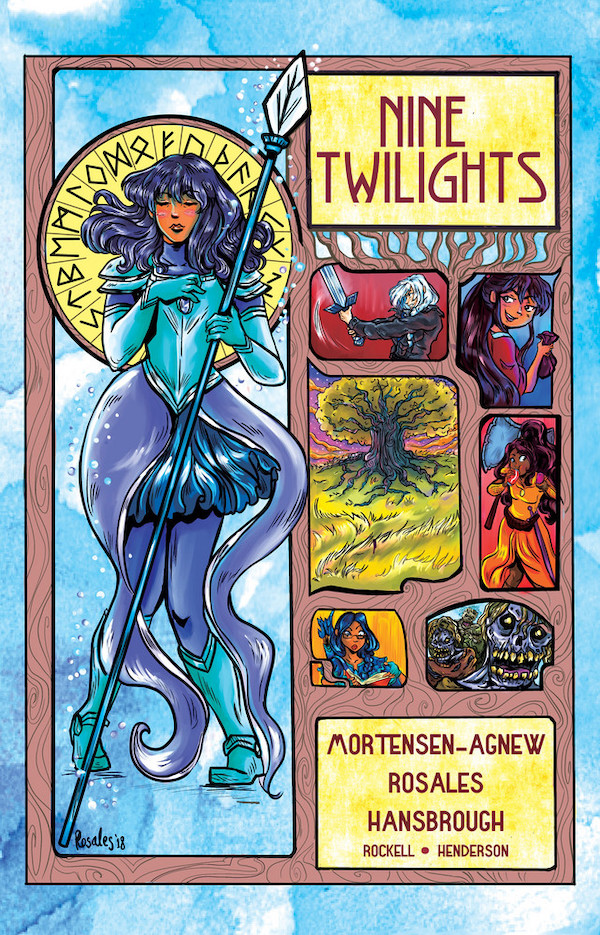
KS: Was Nine Twilights your first “officially” published comics work?
AR: Yes, it was the first project I had collaborated on with others and the first real comic that I had dared to actually present to the world. It was a self-published webcomic, but those are absolutely 100% valid in terms of being considered published. My collaborators – Anne and Chris – and I all really loved webcomics and working on that helped me build a portfolio that allowed me to obtain work in other anthologies and projects.
KS: For any aspiring creators who may be reading this, can you talk about what specifically you got out of those times at conventions, meeting other creators, etc.? Obviously, it’s networking in the big sense, but I’m wondering about any concrete takeaways you found valuable.
AR: One of the main reasons I got into sharing my work at conventions was because I knew I needed to get my work seen to get feedback and establish myself as an artist that was out in the world, creating things. In tabling at conventions, I was relieved to quickly learn that networking isn’t about “what can you do for me?” It’s about creating genuine friendships based on shared interests, passions, and goals. Networking I learned was mainly about finding your people, friends in your same industry you can go to for advice and whom you can also offer support to. Other concrete takeaways have been getting a sense of what comics readers as a whole are looking for. Over the years I’ve seen consistently that fans are eager and excited for authentic representation in their stories and that they love meeting the faces behind their favorite stories. It is also super important to be able to show that you have finished projects on your table to show that you can complete something and that you’re building your portfolio regularly.
Back to the networking thing a bit, it is important to build your friend community and contacts within this industry because that can help you gain guidance and direction at times. Comics is a small industry; I’ve learned that there’s a sort of “six degrees of separation” sort of connection that everyone has, so it’s a good thing to meet folks, and do what you can to support your friends and projects that you believe in. I consider myself so lucky to have been able to meet so many incredible comics writers, artists, letterers, colorists, and editors over the years, and I know that I can ask for advice from them when need be. This is especially important since comics being an industry of freelancers for the most part, it’s helpful to feel like you’re not working in a vacuum and having that camaraderie can be an invaluable resource to help keep you focused, grounded, inspired, and excited to keep creating.
KS: You’ve had a number of stories published in various anthologies. What’s the appeal of that format for a creator? What factors get an anthology on your radar as something you might be interested in?
AR: The appeal at least for me as a creator is definitely the ability to challenge myself to work with different genres, story tones, and even artistic styles. Anthologies have been a place where I’ve been able to experiment in storytelling, and they’ve helped me to grow as an artist as well. In terms of anthologies on my radar that I look for, I tend to look at the overall theme of the book, the target audience, and the other creators working on the book. I also think about what genres I haven’t tried and how I can shake up my storytelling a bit. Of course, I also look at the proposed timelines to see if the project timelines work with my current schedule, but on the whole it’s about the content of the stories and being able to try something new.
KS: Let’s shift over to your time in the DC/Milestone Initiative program and the appeal for you of joining it.
AR: [It] greatly appealed to me because of the rich legacy that both DC Comics and Milestone Media has and the opportunity to receive hands-on training and mentorship from some of the best in the industry. In the ’90s, Milestone was trailblazing not only in the opportunities they were creating but also in representing diverse and LGBTQIA characters, as well. I felt that being able to be among other diverse creators could allow for a tremendously rich experience in creating comics I haven’t really had before and with the support and mentorship from DC’s writers, artists, and editors to guide us, it could help me to grow as an artist and it certainly did.
KS: What was the application process like?
AR: The process for artists involved a three-page sample script from Static that we artists were to pencil and ink, alone with a few essay questions, our resume/publishing credits, and a few rounds of interviews via Zoom. I’m tremendously grateful for the learning experience and for the Milestone cohort familia I gained out of it.
KS: Quick hypothetical: Imagine now I can hook you up to a machine Matrix-style and download expert level skill in any area you don’t have it. This could be something you’ve never even tried, or something you’re decent at but would love to be better. What’s your new area of expertise?
AR: Oof, not to sound like I’m lacking confidence in how I am as an artist, but, sometimes, I wish I could download expert skill in everything! In all seriousness, though, much like many other professions like medicine, law, computer programming, etc., an artist is never done learning. There is always something that can be improved upon. If there was a news ticker in my brain, it’d say something along the lines of “complacency is death” which is to say that you’ll never grow and develop if you don’t try new things — an applicable lesson to all facets of life. Recently, I realized how much I struggle with coloring, and I’d love to learn more about inking techniques. I mean, I’d also love to know Kung Fu, but I think the aforementioned skills would be far more advantageous on a comic page.
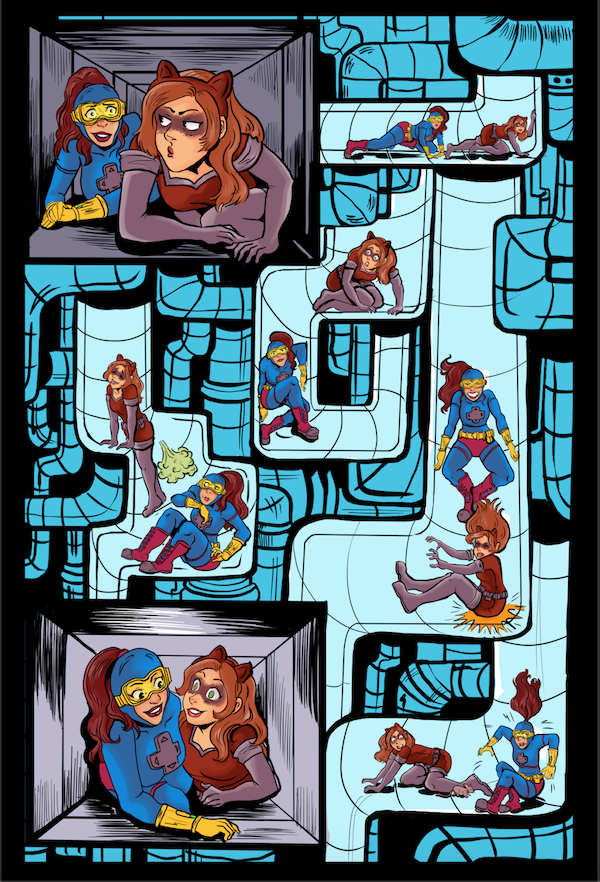
KS: Finally, please let readers know what you have out now and what you have coming in 2023 and beyond…
AR: I’ve got multiple independent comics projects heading to Kickstarter within this next year I’m excited to share. One is Gamer Girl & Vixen, a continuation of an early book of the same name that involves a queer supervillain couple who are thieving to make a name for themselves in a world where superheroes and villains are like influencers. These two gals, Gamer Girl and Vixen, are fighting not only for their love-lives, but for their lives and success as they vie to be the ones on top in the competitive world of super-heisting.
The other project is a modern-day Mexica/coming-of-age graphic novel called Teotihuacan which tells the story of a young Mexican-American teenager from Los Angeles who mysteriously gains the powers, and the voice speaking in his head, of the feather-serpent god, Quetzalcoatl. Together, they have to fight off ancient Mesoamerican monsters invading Los Angeles.
I’m also working on a rad anthology book with my cohort from the Milestone Initiative program, so please be on the lookout for all of these books!

